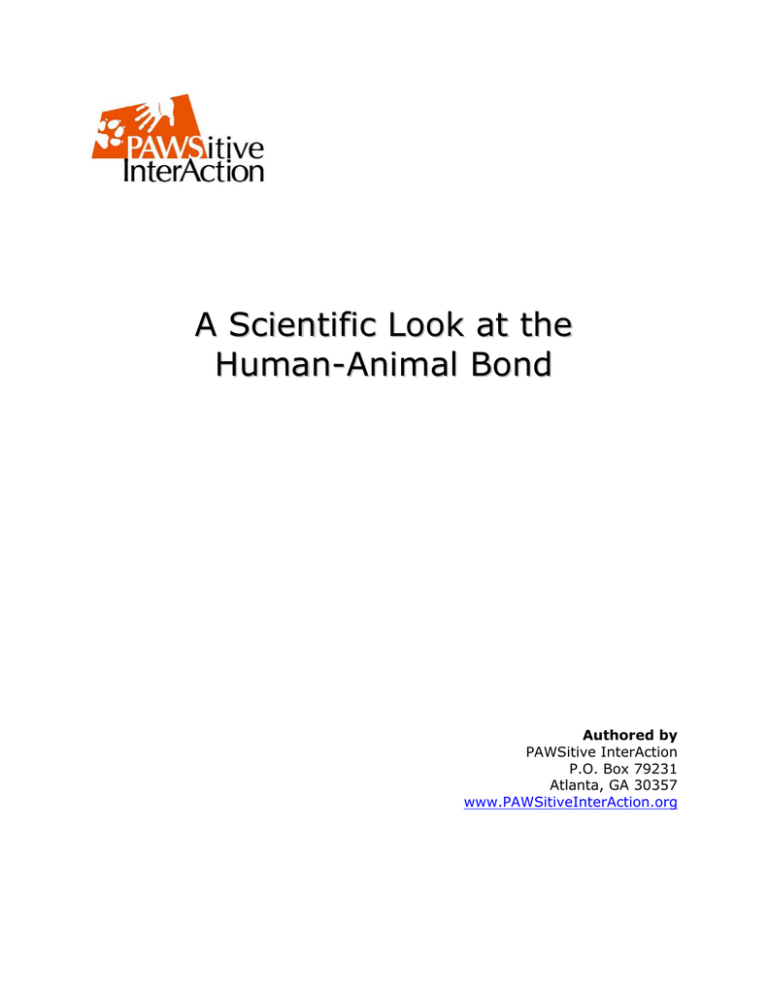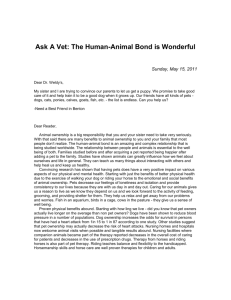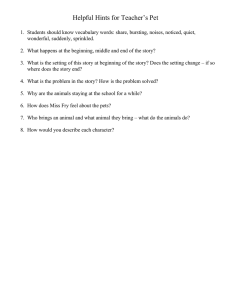
A Scientific Look at the
Human-Animal Bond
Authored by
PAWSitive InterAction
P.O. Box 79231
Atlanta, GA 30357
www.PAWSitiveInterAction.org
Table of Contents
Section
Page Number
I. Introduction
2
II. Health Effects of Animal Companionship
3
III. Mental Health Benefits of Interacting with Companion Animals
4
IV. The Ability to Make Us Happy and Healthy
7
V. Pets, Not Pills: The Healing Power of Fur, Fins and Feathers
VI. Conclusion
7
9
VII. Additional Resources
9
1
Introduction
In May 2002, PAWSitive InterAction held its inaugural educational
Summit – THINK PAWSitive! – in Atlanta, Georgia to promote and
celebrate the positive impact of the human-animal bond. The twopart event was the first of its kind in the Atlanta area. PAWSitive
InterAction, born in May of 2001, is a non-profit alliance of the
following premier Atlanta organizations:
•
•
•
•
•
Atlanta Humane Society: Founded in 1873, the Society exists
for the purpose of preventing cruelty, relieving suffering,
providing humane treatment for animals, and encouraging the
human/animal bond on a regional basis in the state of Georgia.
Happy Tails Pet Therapy: Founded in 1991, Happy Tails is a
non-profit organization of dedicated volunteers and their pets
who perform animal-assisted therapy visits for healthcare
facilities, social agencies and special needs programs.
Merial: An innovation-driven animal health leader, Merial is
committed to enhancing the health and well-being of animals.
Merial, maker of FRONTLINE® and HEARTGARD® brand
products, is one of the world’s leading veterinary pharmaceutical
and vaccine companies.
Pets Are Loving Support (P.A.L.S.): Founded in 1990,
P.A.L.S. is a non-profit organization whose mission is to provide
ongoing care and support for pets of persons living with
HIV/AIDS, critical illnesses and other disabilities in the Atlanta
area.
Zoo Atlanta: Founded in 1889, Zoo Atlanta is empowered to
exhibit, interpret, study and care for wildlife in superior
environments, to conserve biodiversity throughout the world, to
educate, enlighten and entertain the public and to contribute to
the cultural life of the community.
Experts in the areas of medicine, psychiatry, veterinary studies and
epidemiology came together to discuss scientific research and case
studies that validate the therapeutic effects and benefits of humananimal relationships. This paper is a summary of the key
discussions at the summit.
Presenters included:
• Dr. Alan Beck, Director of the Center for the Human-Animal
Bond at the School of Veterinary Medicine at Purdue University
• Dr. Sandra Barker, Professor of Psychiatry and Director of the
Center for Human-Animal Interaction, School of Medicine at
Virginia Commonwealth University
• Dr. Marty Becker, Veterinary correspondent for ABC-TV’s Good
Morning America and author The Healing Power of Pets
®FRONTLINE and HEARTGARD are registered trademarks of Merial Limited.
2
•
Dr. Edward Creagan, Professor at the Mayo Clinic Medical
School, American Cancer Society Professor of Clinical Oncology
and The John and Roma Rouse Professor of Humanism in
Medicine
Award-winning journalist Steve Dale facilitated a panel discussion
with these experts during the Summit.
The wealth of research on the power of the human-animal bond
tells us one thing: the healing power of pets isn’t anecdotal
anymore, but scientific. It is our hope that as hard evidence on the
positive effects of the human-animal bond grows and becomes
more widely understood, the medical field will embrace
nontraditional pet-assisted treatment approaches where
appropriate, to the benefit of humans and animals alike. It is our
fervent wish that more and more people will understand the
scientific basis of the human-animal bond and appreciate the roles
animals play in improving the quality of our lives. By their
dedication to taking care of the health needs of animals, we believe
that veterinarians and their staff play a vital role in keeping the
human-animal bond alive. Likewise, we value the role of health
professionals who research the benefits of human-animal
interaction and look for innovative ways to incorporate companion
animals into healthcare treatment. We are grateful. As part of the
community, we also appreciate and give thanks to the people,
shelters and rescue groups who save animals on a daily basis.
They too are enabling human-animal bonds to survive.
Health Effects of Animal Companionship
Why are animals good for our health? According to Dr. Alan Beck,
director of the Center for the Human-Animal Bond, School of
Veterinary Medicine at Purdue University, animals offer an array of
health benefits.
“The companionship of animals decreases loneliness and stimulates
conversation,” Beck says. “By encouraging touch and giving
humans a sentient creature to care for, interaction with animals
stimulates physical reactions that are very necessary and important
in humans.”
“Many times, pets give attention to a person who otherwise might
not receive as much,” Beck says.
“They stimulate exercise, encourage laughter, and facilitate social
contact,” he explains. “These benefits add up to an improved
sense of well being.”
The tangible benefit of owning pets is one likely reason pet
ownership is on the rise. In a survey conducted by the American
3
Pet Products Manufacturers Association in 2001, 94% of those
surveyed indicated that companionship, love, and company are the
top benefits of owning a dog. But there are many other rewards
that we are only just beginning to understand:
•
•
Benefits of Owning
Dogs
o
Companionship,
love, company
o
Fun to watch
o
Like a child,
family member
o
Relaxation/
relieves stress
o
Good for family’s
health
o
Good for
children, teaches
responsibility
- Dr. Alan M. Beck,
Pioneer in the field of
Human-Animal Bond
•
•
Social Benefits: When people engage in conversation, or enter
into a social situation, often times those involved experience a
rise in blood pressure and anxiousness. Pets help increase our
ability to affiliate with others around us by stimulating
conversation and aiding in the reduction of anxious feelings
people may experience.
Behavioral Benefits: Animals introduce responsibility and a
nurturing behavior into the lives of children as a family pet is
often considered a child’s child. Some 48% of families consider
their pet a family member.
Emotional Effects: Because our pets are often the center of
attention, and because they are, after all, animals, they usually
do things that make us laugh.
Physical Effects: Animals encourage more exercise, which
results in better physical health. The elderly for example, walk
more often and have a much more positive exercise experience
when it is with their pet.
An important study on how animals affect Alzheimer’s disease
patients was unveiled at this Summit. A common side-effect of
Alzheimer’s is a reduction in weight and a loss of appetite. The
study, conducted by Dr. Alan Beck, looked at a group of
Alzheimer’s patients who were placed in front of fish tanks during
mealtime. The study showed that by simply watching fish during
normal eating times, the patients became fascinated, experienced
an increase in appetite and demonstrated metabolic gains in their
weight (See Figure One). This is a definitive study and a valuable
addition to the growing body of scientific evidence about
physiological responses in humans brought about by interacting
with animals. Dr. Beck was also a key member of the research
teams that showed in earlier landmark studies that pets lower
blood pressure1 and prolong the survival rates of people with heart
disease (See Figure Two).2
Mental Health Benefits of Interacting with
Companion Animals
A significant body of research exists documenting the psychological
benefits of animal companionship on mood, well-being and
behavior. More specifically, studies have examined the effect of
1
Katcher AH, Friedmann E, Beck AM, Lynch J: New Perspectives On Our Lives with Companion Animals, University
of Pennsylvania Press, Philadelphia, 1983, Ch 31: 351-359
2
Friedmann E, Katcher AH, Lynch, JJ and Thomas SS: Public Health Reports, 95,307-312, 1980
4
Fish Observation and Metabolic
Weight Gain in Alzheimer’s Patients
Figure One
F o o d In ta k e b y M e a l in G ra m s
700
600
500
400
B a s e lin e
300
T re a tm e n t
P ost
200
100
0
B r e a k fa s t
L unch
Supper
M o n th ly W e ig h ts (N = 6 2 )
162
161
Pounds
160
159
158
157
156
155
-3
-2
-1
+1
+2
+3
+4
M o n t h s b e f o r e a n d a f t e r a q u a r iu m
Dr. Alan Beck
PAWSitive InterAction Summit, May 2002
Reprinted with permission from Sage Publications
Edwards, N.E., & Beck, A.M. Western J. of Nursing Research Oct. 2002 24/5, pp.697-712
One-year Survival after a Heart Attack
Figure Two
All
Pets
No
Pets
No-Dog
Pets
Total
Living
50
(94%)
28
(72%)
10
(100%)
78
(85%)
Dead
3
(6%)
11
(28%)
0
(0%)
14
(15%)
Total
53
39
10
92
Dr. Alan Beck
PAWSitive InterAction Summit, May 2002
One-year survival rate after a heart attack was found to be 94 percent
among pet owners (50 out of 53 pet owners were alive one year after a
heart attack). Among those who did not own pets only 72 percent
survived. This effect was also seen among pet owners who had pets
other than dogs.
5
the human-animal bond on many areas of mental health: how
depression, anxiety, and loneliness are affected by interacting with
animals; and how pets can positively influence social interactions.
“We now know that stress is implicated as an important factor in
the development of cardiovascular and other chronic diseases. This
means that the link between animals and mental health has great
therapeutic potential and deserves further examination,” says
Sandra Barker, Professor of Psychiatry and Director of the Center
for Human-Animal Interaction in the School of Medicine at Virginia
Commonwealth University.
“Research shows that
even patients with
chronic illnesses,
including heart
disease and HIV, can
be helped through the
human-animal bond
and its physiological
and psychological
benefits.”
- Dr. Sandra Barker
Psychiatry Professor,
Human-Animal
Interaction
Researcher
So how do animals figure in the stress equation?
The proof is in the research. In a 1998 study of 241 patients,
researchers examined whether an animal-assisted therapy session
would reduce the anxiety level of hospitalized psychiatric patients,
and if reductions in anxiety differed by diagnosis.
One group of patients participated in animal-assisted therapy with
a dog, while a control group participated in regularly scheduled
therapeutic recreation sessions without animal-assisted therapy. It
was found that the animal-assisted therapy sessions had a
significant effect on participating patients, specifically bringing
about a significant reduction in anxiety for patients with mood and
psychotic disorders. 3
Research has also been conducted to determine if the presence of
an aquarium affects patients prior to electroconvulsive therapy,
which is often used as a last means of treatment for severely
depressed patients. Prior to this type of treatment, patients
generally experience elevated levels of fear, depression, and
anxiety. Results of the study showed a trend towards decreased
levels of anxiety in the room with the aquarium.4 Many doctors’
offices have adopted this easy-to-incorporate approach for easing
patient anxiety and have installed aquariums in their waiting
rooms.
What experimental studies don’t reveal is the powerful, qualitative
impact of human-animal interaction on a single individual; numbers
alone cannot measure these feelings or capture adequately the
visible calming of agitated patients in the presence of a dog, or
explain fully the smile that emerges on the face of a fearful and
anxious child when a therapy animal enters the hospital room.
3
4
Barker SB & Dawson KS, Psychiatric Services, June 1998 49(6), 797-801
Barker SB, Rasmussen KG & Best AM, 2001 (manuscript in preparation)
6
The Ability to Make Us Happy and Healthy
When most people think of the human-animal bond, they think
companionship: the tail-wagging hello at the end of a hard work
day, the muzzle come to rest on a tired thigh, the Saturday walk in
the park. But, we now know that the human-animal bond
transcends companionship. It is a strong, positive and mutual
interaction between humans and animals—a special bond that
actually enhances human quality of life.
“I believe having a
pet has all the
benefits of an
antidepressant drug,
and more - but
without a single side
effect.
Pets play a vital role
in ameliorating the
effects of chronic
medical conditions.”
- Dr. Marty Becker
Veterinarian, Author,
Human-Animal Bond
Guru
Promoting human-animal interaction generates far-reaching
benefits. Only during the past five years have researchers
determined that animals are good for our health, lending scientific
proof to the theory that pets do affect us emotionally, physically
and psychologically.
“Pets play a vital role in ameliorating the effects of chronic medical
conditions,” says Dr. Marty Becker, Veterinary correspondent for
ABC-TV’s Good Morning America and author The Healing Power of
Pets. “Researchers have discovered that children who are exposed
to pets early in life actually develop fewer allergic reactions.
Scientists now believe that the child-pet contact may help build up
the body’s defense systems against certain allergens. This early
interaction may keep children from developing chronic allergic
reactions as they grow, rather than triggering them as once
believed.”
Children benefit in other ways too. Pets and children are a natural
combination of energy and playfulness. Many researchers now
believe that children with attention deficit hyperactivity disorder
(ADHD) can benefit from a large dog, which can provide an
energetic playmate and a source of centering for a child with
ADHD. Pets are also shown to provide emotional comfort and
support for children whose parents are going through a divorce.
With the elderly, too, pets can play a pivotal role in health and wellbeing. Arthritis is a common condition among older Americans.
Studies show that a small pet can be very beneficial to arthritis
sufferers. Stroking an animal may make the animal feel better, but
it also has a calming effect on arthritic inflammation and can prove
to be very relaxing.
Pets, Not Pills: The Healing Power of Fur, Fins
and Feathers
There is no denying that pet owners have a strong bond with their
animals. Even the tragically ill are determined to get home to see
their pets, resulting in a stronger drive to rehabilitate after an
injury or illness. Dr. Edward Creagan, a professor of medical
7
oncology at the Mayo Clinic, had a cancer patient who was very ill,
but determined to make it home to see “Max.”
"I thought he was talking about his son, Max, or Maxine, his wife,”
Creagan explains. “It turns out he was talking about his dog, Max.
We can no longer ignore the medical significance of the bond
people have with their pets. There is a rock-solid, indisputable
mind-body connection that is vectored by our pets. Our pets create
a balance between our minds and our bodies.”
“Veterinarians take
care of the entire
family, they do not just
treat the pets.
I prescribe pets to a
third of my cancer
patients to help them
cope with the rigors of
their terrible disease.
I consider getting a pet
to be one of the easiest
and most rewarding
ways of living a longer,
healthier life. ”
- Dr. Edward Creagan
Celebrated Mayo Clinic
Oncologist,
Human-Animal Bond
Ambassador
And balance is in great demand today, with stress in abundance.
Not only are Americans experiencing physical exhaustion from life’s
everyday complications, but some 40 percent of Americans will be
hospitalized from one of a host of psychological maladies, according
to recent research. Thirty-three percent of Americans will
experience an emotional breakdown, and 27 percent will experience
suicidal thoughts.5 Clearly Americans are worn out, and in need of
an outlet to reduce stress.
Pets provide the avenue for change. They play an important role in
reducing stress by providing a vector of wellness, encouraging
physical activity at the end of the day, and offering an opportunity
to incorporate exercise into daily routines.6
And the human-animal bond is growing in importance within
American families as well. A survey of 1,197 pet owners conducted
by the American Animal Hospital Association found that 34 percent
of pet owners say they talk about their pets when conversing with
others, while only 20 percent say they talk about their spouses.
Fully 78 percent report that it’s their pet, not their spouse, who
greets them first as they come home from work.
Physiological aspects of the human-animal bond now under
investigation include the effects of pet ownership and ACE inhibitors
on human hypertension, the effects of human-animal bonding on
neurochemical indicators, the effect of dogs on children undergoing
dental procedures, the impact of pet ownership of caregivers, and
the effects pets have on elders.
Pets affect physiological health in a number of ways. Pet ownership
can help lower blood pressure and triglycerides, aid in fewer
physician visits, and decrease loneliness. Pets can also reduce
depression, increase heart attack survival, and offer unconditional,
nonjudgmental affection.7
In a one-year study of 1000 participants, researchers investigated
how companion animals affect the health of older people. Results
demonstrated that companion animals enhance health, decrease
5
6
7
Swenson R, Margin, NavPress, March 1995
Associated Press poll, JCO, Ed Res, 1997
Generations, Vol. XXV, no. 2, Summer 2001 & New York Times July 24, 2001
8
depression and increase happiness. Companion animals are a
factor for successful aging among the elderly participants.8
Conclusion
“The humananimal bond
occurs in ways
we don’t always
think about.
Pets teach us to
enjoy the simple
joys of life.”
- Steve Dale,
award-winning
journalist
Research presented at the summit educated participants on the
positive effects animals have on our physical, mental, emotional
and psychological health. Leaders in the field of human-animal
studies highlighted specific research on how animal-assisted
therapy helps psychiatric patients overcome anxiety and
depression; how heart attack victims experience lowered blood
pressure while with an animal; how fish aquariums have a positive
effect on Alzheimer’s patients; how children bond with animals; and
how pets overall contribute to relaxation, lowered depression and
anxiety, and increased happiness. In addition to the research,
presenters and community participants shared anecdotes and case
studies with attendees.
Science has officially weighed in on the human-animal bond, and
the evidence is clear. Research demonstrates that human-animal
interaction benefits physical, emotional, and psychological wellness.
In the next three to five years, researchers hope that patients will
have greater access to their pets while in the hospital, to lend a
healing paw when needed most. As researchers continue to
explore the health benefits animals provide, more and more
members of the healthcare community will recognize animals as a
valid and effective form of therapy for humans of all ages.
PAWSitive InterAction, Inc.
PAWSitive InterAction Inc. (www.pawsitiveinteraction.com) is a
non-profit alliance of premier Atlanta organizations dedicated to
recognizing the positive effects of animals in our lives and
celebrating and promoting the human-animal bond. The group’s
mission is to collectively connect people in the community with
resources, expertise and education designed to further
understanding of the positive benefits of interacting with animals.
Additional Resources
1. Between Pets and People – The Importance of Animal
Companionship - Alan Beck and Aaron Katcher, Purdue
University Press, 1996.
2. The Healing Power of Pets – Marty Becker, Hyperion, 2002
3. Delta Society fact sheet – Healthy Reasons to Have a Pet
http://www.deltasociety.org/press.htm
8
J Am Ger Soc 3-99
9
Founding Members of PAWSitive InterAction
2002 PAWSitive InterAction, Inc., Atlanta, GA. All rights reserved.
PAWSitive InterAction encourages wide dissemination of this publication; for details
about obtaining a license go to www.PAWSitiveInterAction.org.






